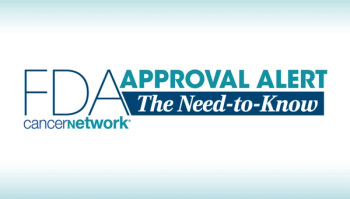
FDA Grants Priority Review to Tafasitamab/Lenalidomide Combination for DLBCL
The FDA granted priority review to a biologics license application for tafasitamab in combination with lenalidomide for the treatment of patients with relapsed or refractory diffuse large B-cell lymphoma.
The FDA granted priority review to a biologics license application (BLA) for tafasitamab in combination with lenalidomide (Revlimid) for the treatment of patients with relapsed or refractory diffuse large B-cell lymphoma (DLBCL), according to MorphoSys, the developer of the anti-CD19 antibody.1
A Prescription Drug User Fee Act (PDUFA) goal date was set for August 30, 2020. Additionally, the FDA has notified the company that they are not currently planning to hold an advisory committee meeting to discuss the application.
“We are extremely pleased that the FDA has accepted filing of our application and granted priority review, as we believe that the combination of tafasitamab and lenalidomide may provide an additional treatment option for patients suffering from DLBCL, who have relapsed after or are refractory to the current standard of care,” Malte Peters, MD, chief development officer of MorphoSys, said in a press release. “We would like to thank all patients participating in our clinical studies and we will continue to work relentlessly towards making tafasitamab available to patients.”
The submission was based on the primary analysis data from the L-MIND trial of tafasitamab in combination with lenalidomide in patients with relapsed or refractory DLBCL and the retrospective observational matched control cohort Re-MIND evaluating efficacy outcomes of relapsed or refractory DLBCL patients with received lenalidomide monotherapy.
L-MIND is a single arm, open-label phase II study evaluating the combination in patients with relapsed or refractory DLBCL after up to 2 prior lines of therapy who are not eligible for high-dose chemotherapy and subsequent autologous stem cell transplantation. Primary analysis data, with a cut-off date of November 30, 2018, included 80 participants enrolled in the trial who had received tafasitamab and lenalidomide with a follow-up of at least 1 year. The primary endpoint, defined as best objective response rate (ORR) compared to published data on the respective monotherapies, was met.2
As of May 2019, the study had reached its primary completion. The ORR was 60%, and the complete response (CR) rate was 43%. Moreover, 81% of the CRs were PET (positron-emission tomography)-confirmed, and the median progression-free survival was 12.1 months with a median follow-up of 17.3 months. Responses were durable with a median duration of response of 21.7 months, though median overall survival was not reached (95% CI, 18.3 months – not reached) with a median follow-up time of 19.6 months. The 12-month overall survival (OS) rate was 73.3%.
Re-MIND, an observational retrospective study, was designed to isolate the contribution of tafasitamab in the combination with lenalidomide to prove the combinatorial effect. Collecting efficacy data from 490 relapsed or refractory DLBCL patients in the US and Europe, the study compared this data with efficacy outcomes from the L-MIND trial. This resulted in 76 eligible Re-MIND patients being matched 1:1 to 76 of 80 L-MIND patients based on specified baseline characteristics.
The primary endpoint of the study was met and showed a statistically significant superior best ORR of the combination compared to lenalidomide monotherapy.3 ORR was 67.1% (95% CI, 55.4-77.5) for the combination of tafasitamab and lenalidomide, compared to 34.2% (CI: 23.7-46.0) for the lenalidomide monotherapy (P < 0.0001). Furthermore, superiority was consistently observed across all secondary endpoints, including CR rate (tafasitamab/lenalidomide combination 39.5%; CI: 28.4-51.4 vs lenalidomide monotherapy 11.8%; CI: 5.6-21.3; P < 0.0001), as well as in pre-specified statistical sensitivity analyses. There was also a significant difference observed in OS, which was not reached in the combination as compared to 9.3 months in the lenalidomide monotherapy (hazard ratio 0.47; CI: 0.30-0.73; P < 0.0008).
The submission of the BLA was announced by MorphoSys in December 2019. The FDA granted Breakthrough Therapy Designation for the combination of tafasitamab and lenalidomide in relapsed or refractory DLBCL in 2017.
References:
1. FDA Accepts MorphoSys’ Biologics License Application (BLA) and Grants Priority Review for Tafasitamab and Lenalidomide for the Treatment of Relapsed/Refractory DLBCL (news with additional features) [news release]. Planegg/Munich, Germany. Published March 2, 2020. morphosys.com/media-investors/media-center/fda-accepts-morphosys-biologics-license-application-bla-and-grants. Accessed March 2, 2020.
2. MorphoSys Presents Primary Analysis Data from L-MIND Study of Tafasitamab (MOR208) in combination with Lenalidomide in r/r DLBCL at ICML 2019 [news release]. Planegg/Munich, Germany. Published June 22, 2019. morphosys.com/media-investors/media-center/morphosys-presents-primary-analysis-data-from-l-mind-study-of. Accessed March 2, 2020.
3. MorphoSys AG: Primary Endpoint met in Real-World Data Study Demonstrating Clinical Superiority of the Combination of Tafasitamab and Lenalidomide compared to Lenalidomide alone. Planegg/Munich, Germany. Published October 29, 2019. morphosys.com/media-investors/media-center/morphosys-ag-primary-endpoint-met-in-real-world-data-study. Accessed March 2, 2020.
Newsletter
Stay up to date on recent advances in the multidisciplinary approach to cancer.



















































































